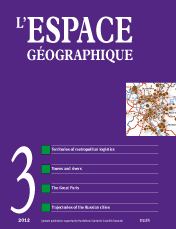

River logistics and metropolitan project
Antoine FRÉMONT. Developing territories of metropolitan logistics. The example of river towns
Inland waterway transport in the Pearl River Basin, China (10 fig., 2 tables)
The worldwide concerns about global warming and highway traffic congestion are among the incentives to revitalize inland waterway shipping in some developed countries. In contrast, in developing countries such as China, highway constructions are still considered as the most efficient way to bring economic prosperity into a region. This paper argues that among the multiple causes that led to the underperformance of inland waterway transport (IWT) in the Pearl River Basin (PRB), the lack of government support to facilitate and promote the IWT-based intermodal system is critical. After comparing the IWT in eight countries, we highlight two major characteristics for the PRB: (1) since the 1990s IWT has experienced, a unique development trajectory – moving from push-barges to small motorized vessels, which is the reverse of the current trend in most developed countries, on account of the ‘‘coastilization’’ of the export-oriented economies; (2) the lack of investment and proper governance has led to physical bottle-necks and to a deterioration in the quality of the navigational channels in the lower reaches, and other operational barriers have further weakened IWT.
keyword: CHINA, INLAND WATERWAYS, MANAGEMENT, PEARL RIVER DELTA
Transport and reorganization of the relations between city and harbour on the Paraná river. The case of the metropolis of Rosario (Argentina) (5 fig.)
The presence of a large river such as the Paraná in Argentina is, paradoxically, both an asset and a constraint. While the river serves the logistics of transport, the evolution of the distribution of commercial flows and changes in the world merchant fleet have engendered a reorganization of the urban structure of the country. This article analyzes the city of Rosario, where cooperation between public and private actors is emerging. The different strategies of connection to the “river highway” shows an evolution in the competition and the complementarity between city ports and the logistic complexes that are located outside the cities. This article analyzes the reorganization of the urban system on the scale of Argentina as a whole, and the local impact of the recent evolutions on the city of Rosario.
keyword: FLUVIAL TRANSPORT, LOGISTICS, PRIVATE ACTOR, PUBLIC ACTOR, CITY-PORT RELATIONSHIP
Connecting, disconnecting and reconnecting: port logistics and Vancouver’s Fraser River (1 fig., 1 table)
This historical and descriptive article concerns the urban portions of the Fraser River, and aims to reveal the role that the river has played, continues to play, and might play in the future, in the logistics of the Vancouver metropolitan region. It identifies factors pertaining to urban property markets, regulation, infrastructure and patterns of land use that strongly shape conditions for river transportation. The goal of reestablishing the central role of urban river ports and waterways in transportation thus faces considerable challenges from competing urban land uses, in addition to the well-known challenges that water transportation faces in terms of cost competition with other modes of transport.
keyword: FRASER RIVER, PORT-LOGISTICS, RIVER PORT, URBAN PROPERTY, VANCOUVER
What role for the Seine in the Great Paris freightmarket? (7 fig., 4 tables)
Can the river Seine play a key role in the freight transport system in “Grand Paris” (Greater Paris), from international flows to urban distribution outlets? Firstly, a systemic approach to the freight transport system within metropolitan areas is outlined. The prominence of the road system has led to a twofold disconnection between the river and the city, a disconnection from production and distribution processes, and also a spatial disconnection highlighted by the process of “logistics suburbanization”. As a major European metropolitan area, Paris provides a very useful example. The paper recommends reconnecting the river to the city for freight transport. This can only be achieved through strongwilled metropolitan planning and policies aimed at freight and logistics activities.
keyword: FREIGHT TRANSPORT, LOGISTICS, METROPOLITAN AREA, RIVER, SUBURBANIZATION, URBAN PLANNING
Ports in metropolitan negociation: the example of Basel (4 fig., 2 photos, 1 table)
Unlike sea ports with large land reserves, rivers ports often lack space for territorial extension. This common situation may explain why, for a long time, river port authorities were reluctant to give up any land for urban use, in spite of continuous losses in traffic volumes and increasing pressures from real estate and public actors. In most cases, the urban waterfronts developed by their maritime counterparts have been rejected by river port authorities as an urban model that would merely accelerate the decline of the port, or hinder any later recovery. The Basel case study shows, on the contrary, how negotiations based on an ambitious urban project can be compatible with the port redevelopment. The paper examines the strategies that will strengthen the position of Basel as part of the major transport corridor of the Rhine, and as a crossborder metropolis.
keyword: CROSSBORDER COOPERATION, METROPOLITAN LOGISTICS, RHINE CORRIDOR, RIVER PORT, WATERFRONT
Urban growth
An intermediate system. Trajectories of Russian cities between general dynamics and specific histories (8 fig., 3 tables)
After testing the validity of the concept of city systems in the Russian context, we assessed interest of several urban models in apprehending Russian cities and comparing them with other city systems. Gibrat’s model, for instance, showed an interesting ability to describe the mechanisms of urban growth. Deviations from this model were sought by studying the specific trajectories of different city groups, on various time scales (from one and a half centuries to a couple of decades). These deviations reveal factors of different types – political, economic, localisation of resources and historical accidents.
keyword: SYSTEM OF CITIES, RUSSIA, TRAJECTORY, URBAN HISTORY, URBAN MODEL
L’espace géographique 2/12![]()
![]() L’espace géographique 4/12
L’espace géographique 4/12
For subscribe or buy this issue: BELIN
![]() L’Espace géographique: contents
L’Espace géographique: contents
Last modified: April 2, 2013